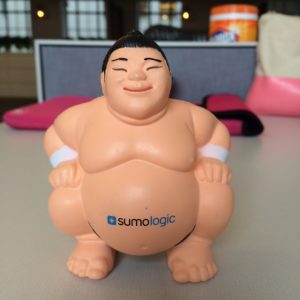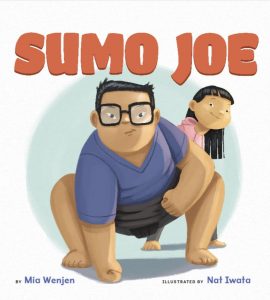I was standing in the line at a dive Brazilian buffet restaurant with my husband for lunch. The food is inexpensive and delicious and we joke that this would be like visiting our grandmothers if they lived nearby and were Brazilian.
There was a line at the meat counter where it’s sliced off the skewers for you. A contractor was in front of me. He was a big guy, but not immense. All of a sudden, the image of sumo popped into my head. By the time, I sat down with my food, I had all kinds of rhymes about Sumo Joe. I quickly typed them into my phone and then sat down to eat.
Nothing much happened for a few weeks. Then one day, I had to go into work for a meeting and needed to find someone about a project I was working on.
 My office is a “hoteling” system so no one has assigned desks. Instead, everyone gets with a storage locker and a file folder drawer to store their stuff (which encourages electronic files), and can sit anywhere they want all day in a series of “neighborhoods.” Thus, no one really has stuff on their desk; without an assigned desk, there’s very little family photos or pencil holders on the workspace.
My office is a “hoteling” system so no one has assigned desks. Instead, everyone gets with a storage locker and a file folder drawer to store their stuff (which encourages electronic files), and can sit anywhere they want all day in a series of “neighborhoods.” Thus, no one really has stuff on their desk; without an assigned desk, there’s very little family photos or pencil holders on the workspace.
So… imagine my surprise to run into this:
It’s a sumo squeeze ball! I told the person with the sumo squeeze ball that I had an idea for a picture book and started reciting my random sumo rhyming lines. She laughed and said it sounded fun.
I sat down in earnest with my phone notes, and my picture book started to take shape. Also, strangely, I was seeing sumo wrestlers everywhere. Was it a sign?

I had signed up for a community education class on children’s book writing and wrote Sumo Joe for this class. After a few rounds of critique from my classmates and teacher, I decided, on a whim, to enter the Lee and Low Publishing New Voices Competition. I didn’t win, but they invited me to receive their editorial feedback and resubmit.
Dear Mia,
Good afternoon Mia,
Thank you for your patience as I revisited your manuscript, SUMO JOE. As I discuss it further with my editorial team, now would be a great time for you to expand the story’s back matter with an Author’s Note.
Many of our titles include back matter material that provides further information about the subject of the story. The Glossary of Terms you included with SUMO JOE is a strong start. I would like to expand this back matter to include an Author’s Note. Your Author’s Note is a place for you to discuss themes or topics related to your story that the text does not explore. Some topics you could discuss include: your inspiration for the story, the practice of sumo wrestling by kids, and the participation of female athletes in sumo wrestling. Please keep in mind that SUMO JOE could be young readers’ introduction to the sport of sumo wrestling, so consider: what would you want them to take away from this reading experience?
Please let me know if you are interested in developing your manuscript further with an Author’s Note. I am happy to address any questions or concerns you may have as you work on it.
Thank you,
Kandace
I’m in the process of editing my Back Matter page and resubmitting it to Lee and Low. Here’s my 4th draft:
Sumo Joe Back Matter
Sumo comes from the ancient Japanese religion, Shinto, which dates back to the eighth century. Described as “the way of the gods,” Shinto centers around the belief in the sacred power, kami, of animate and inanimate things. Kami are benevolent spiritual elements that exist in nature and ones’ ancestors and bring good luck if treated respectfully. The Shinto religion makes use of rituals that enable humans to communicate with kami. These rituals include sumo competitions, as well as music, poetry, dance, and drama performances.
While sumo began as a Shinto ritual, it changed over time encompassing both an art and a sport. In the beginning, sumo matches were held at Shinto shrines in the dedication of the gods in hopes of a good harvest. Over the centuries, sumo shifted from a religious ritual to important military art. When the civil wars of Japan ended in 1603, sumo shifted again to a formalized sport for the benefit of the gods. Today sumo tournaments raise money for the construction and repair of Shinto temples and shrines.
While there were instances during the long evolution of sumo that included women competing in the ring, sumo has always traditionally been considered a male sport. Women are not allowed to touch the dohyo (ring) once it has been purified. In earlier times, women were not even allowed to watch sumo matches!
The rules of sumo are simple: two sumo wrestlers compete in a fifteen-foot round ring (dohyo). Using any of seventy sumo techniques that include pushing, shoving, slapping, throwing, tripping, or grappling, the sumo wrestler that knocks his opponent down or out of the ring wins.
While sumo wrestlers are known for their great size, there are no weight divisions. Wrestlers can weigh more than five hundred pounds, though there is a minimum weight of 165 pounds and a height requirement of at least five feet, six inches. And while size is an advantage in sumo, there are successful champions who weigh much less than their opponents, as strategy, agility, grappling skill, and quickness all contribute to a sumo wrestler’s success.
There are part-time training opportunities at sumo schools (heyas) for young boys, but pursuing a career as a sumo wrestler is a life choice. Sumo hopefuls join a heya and move in, full time, starting as young as fifteen years of age. The sumo stable becomes the aspirant’s new home; he only moves out when he reaches a certain level of success or quits.
The training schedule beings early at around 5:30 in the morning, when the lowest-ranked sumo wrestlers practice first. Around 8:00 am, higher-ranked sumo wrestlers and the sumo coach join the practice. The curriculum also includes classroom time learning about the history of sumo, sports medicine, poetry, and calligraphy. After this period of study, it’s time for lunch, the first meal of the day. Chankonabe, a one-pot stew, is the traditional lunch, consumed with many bowls of rice and beer. Lunch is followed by a rest period. This schedule of training, a huge lunch, and rest period help sumo wrestlers gain weight.
Training for sumo include exercises designed to build strength and increase flexibility. Sumo wrestlers practice shiko — the iconic leg stomping exercise — hundreds of times a day. Shiko is also used during the rituals in tournaments. Teppo is a pushing exercise for the arms and shoulders that is done using a wooden pole in which the sumo wrestler strikes the pole repeatedly with his palms. Practice matches, aerobic exercises and weight training are part of the regimen. Flexibility is also important: sumo wrestlers can do full side splits while resting their heads on the ground!
The competition structure for sumo matches is built to specific requirements. The sumo platform is raised two feet off the ground and made up of a square containing the circular dohyo in the center. The dohyo is constructed using special dirt from the Chiba prefecture. The ring is marked off by a few inches of raised material, made of straw. Outside the ring is a thin layer of sand, used to help identify if a wrestler has lost by touching the outside of the ring. A wooden roof covers the dohyo; the design significant of Shinto shrines. The roof has tassels draping from each corner, symbolizing the cardinal directions.
Sumo wrestlers are famous for their competition uniforms. In the ring, they wear a thick loincloth waist belt called a mawashi made of thirty feet of cloth passed between the legs and wrapped around the waist. The mawashi is an important element of sumo. If it falls off, which is rare, the wrestler automatically loses. Grabbing an opponent’s mawashi is also a strategy to throw him out of the ring. The sumo wrestlers’ hairstyle is also iconic. Their hair is styled in a topknot, with higher ranking sumo wrestlers’ hair styled elaborately to resemble a Ginko leaf.
Sumo matches are conducted by a referee who stays in the ring, as well as five judges who sit outside the ring. The referee also conducts the purification ceremony to cleanse the ring that includes salt and sake offerings to the gods. Each wrestler also performs pre-bout purification rituals that include the shiko exercise, believed to drive evil spirits from the ring. Sumo wrestlers also throw a handful of salt to cleanse the ring each time they enter it.
Once the rituals are completed, the match can begin. The sumo wrestlers start from a crouching position, facing each other from marked spots. When the referee signals the start of a match, they charge at each other with explosive power. Most matches are over in a matter of seconds, though some matches can last as long as a couple of minutes.
Six grand sumo tournaments held in Japan each year. Each tournament lasts fifteen days, with each sumo wrestler competing daily. After the tournament, sumo wrestlers move up or down in their ranking level depending on their win/loss record.
There are four levels that a young sumo wrestler must work his way up, in an up or out system that rewards success with high wages including gifts from patrons. An additional two levels with limited spots are reserved for the most successful sumo wrestlers and are considered “hall of fame” status. Sumo wrestlers who make the highest level, Yokozuna or Grand Champion, must retire if they lose a match.
While sumo is considered a distinct Japanese sport, foreigners have joined the sport with much success. The most famous is Akebono Tarō from Hawaii. He weighed in at 550 pounds and was the first non-Japanese-born wrestler to reach Yokozuna status. Konishiki, also from Hawaii, was the largest Sumo wrestler in history, weighing in at 650 pounds! He was the first non-Japanese-born wrestler to reach ōzeki, the second-highest rank in the sport.
While sumo is an ancient sport with religious roots, it continues to be a popular sport in Japan. As a participant, sports fan, or consumer of sumo’s famous Chankonabe stew, sumo is a wonderful way to experience Japanese culture!
Bibliography
Gutman, Bill. Sumo Wrestling. Minneapolis: Capstone Press, 1995.
Hall, Mina. The Big Book of Sumo. Berkeley: Stone Bridge Press, 1997.
Long, Walter. Sumo: A Pocket Guide. Rutland: Charles E. Tuttle Company, 1989.
My picture book is a rhyming story about a boy learning sumo. His younger sister sneaks into the training facility and challenges him to a match. Since sumo is a “boy-only sport,” she uses aikido for a surprise ending.
I’ll keep you posted on what happens to my manuscript!
p.s. Editorial feedback on my Back Matters page is welcome!
p.p.s. Related posts:
Sumo Joe makes Bank Street Best Children’s Books of the Year list!
SUMO JOE reviewed in BookList & Other Updates
Sumo Joe Reviewed in Publishers Weekly!
Wow! SUMO JOE got a Great Review from Kirkus!
SUMO JOE Illustrator Nat Iwata
Meeting My Editor for SUMO JOE
Taking a Children’s Book Writing Class
10 Unexpected Gifts from Blogging for the Last Decade
My First Book Festival: Chappaqua Children’s Book Festival
To examine any book more closely at Amazon, please click on image of book.
As an Amazon Associate, I earn from qualifying purchases.
Follow PragmaticMom’s board Multicultural Books for Kids on Pinterest.
Follow PragmaticMom’s board Children’s Book Activities on Pinterest.
My books:
Food for the Future: Sustainable Farms Around the World
- Junior Library Guild Gold selection
- Selected as one of 100 Outstanding Picture Books of 2023 by dPICTUS and featured at the Bologna Children’s Book Fair
- Starred review from School Library Journal
- Chicago Library’s Best of the Best
- Imagination Soup’s 35 Best Nonfiction Books of 2023 for Kids
Amazon / Barefoot Books / Signed or Inscribed by Me
















This is so exciting, Mia! I think it would be just amazing if, after blogging about children’s books for years, you published a children’s book! I can’t wait to hear more!
Thanks so much Dee! I’ll keep you posted on what happens!
This is wonderful, Mia!! Congratulations! I smell a PB deal!!!
Thanks so much Maria! Fingers crossed!
So exciting!! Can’t wait to read your book one day, hopefully soon!
Thanks so much Sarah. It would be a dream come true!
Very informative website this helps us a lot so thanks for sharing this post with us.
Thanks so much!
This is so exciting, Mia! I hope to follow in your footsteps someday (hopefully sooner rather than later).
Hi MaryAnne,
Let’s talk soon! I have some publishing contacts now so maybe I can help you with getting published. Do you want to Skype me?
Congrats, Mia! Sounds great, just wanted to bring two typos to your attention, if I may… In the paragraph that talks about the uniform, this sentence “….if it falls OFF, which is RARE….”
Best of luck with this project!
Thank you so much Rosie!!!! I totally need this help! I am correcting my manuscript right now!
Mia, I am so happy for you with your great feedback from Lee and Low! I found your authors note very interesting. I had not known some of the information about sumo wrestling! Did you know anyone who loved sumo ? I wish you much luck and look forward to hearing more as you are on your path to publication😊
Thanks so much Kathleen! I have only ever watched Sumo on TV, a little on cable when it comes up randomly and when I was in Japan, I saw it on the company shuttle bus and during lunch when employees relax and watch TV. I didn’t know too much about it except that I knew it was associated with a Japanese religion so it was a fun journey to learn more and write a story around it. There is sumo in the United States, though not in my area.
This is wonderful and exciting, Mia! I will have to stay tuned.
Thanks so much Penny! It just got acquired by Lee and Low!
This is so exciting Mia! I have everything crossed foe you :o)
Thank you Catherine! It just got acquired by Lee and Low a week ago!